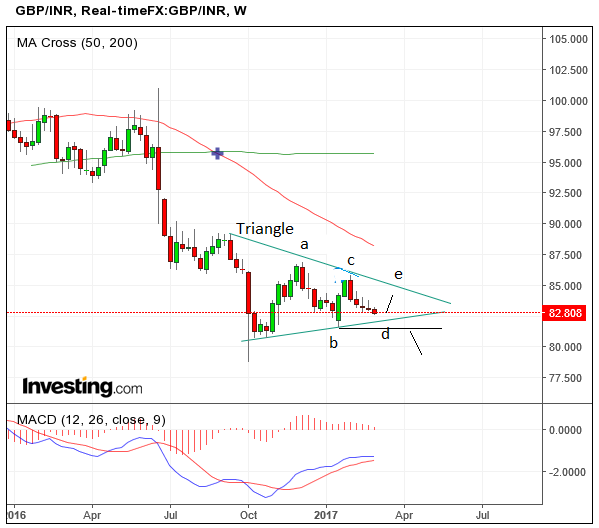Pound Forecast to Extend Decline Against Indian Rupee

The GBP/INR exchange rate traders lower at the start of the new month being quoted at 83.22; the exchange rate started February at 85.23, confirming momentum to be negative.
Concerning the outlook, our technical studies suggest weakness is likely to extend over coming days and weeks.
Overall the exchange rate is forming a symmetrical triangle on the weekly chart, with the probabilities slanted to a break lower once completed.
It is currently unfolding the ‘d’ wave of the triangle, which looks unfinished and will probably move lower, finishing at the bottom of the pattern at around the 82.4000 level.
Normally triangles have five composite waves (a-e) so given this triangle is still forming wave ‘d’ it still has some way to go before it completes.
The dominant downtrend indicates a higher probability that the triangle will break lower than higher.
Often triangles compromise the penultimate move within a bigger trend, which could mean that there may only be one more wave of selling before the bigger downtrend ends.
A break below the 81.65 lows would confirm a breakout lower, towards a target at roughly 77.50, calculated from extrapolating the height of the triangle at its widest point down from the break, and because it is a major round number and therefore is expected to attract a higher-than-average amount of demand.
Indian GDP Beats Expectations
Data out on Tuesday showed India GDP data for Q4 2016 surprising to the upside.
The data showed growth of 7.0% which was above the 6.5% consensus estimate and was all the more surprising because economists had expected growth to be severely curtailed by the authority’s decisions to remove from circulation high denomination notes during the autumn.
Demonetization, as it was called, was aimed at encouraging Indians to use banks and shift the country away from a predominantly cash economy.
It was expected to hurt the economy given the large amounts of cash which were taken out of circulation and deposited in bank accounts or simply lost because people failed to convert their notes before the decommissioning deadline.
The rate of growth beat estimates from the IMF, the Bank of India and the OECD.
The OECD noted that India stood out as an example for other economies given its extraordinarily strong growth rate.
“Paris-based think tank OECD had today said, “India has been a star performer in gloomy times. We do not have many cases of 7 per cent growth… It is a top reformer among all the G-20 countries,” said the Indian Express.
The OECD’s Secretary General Angel-Gurria added that the government must keep up its pace of reform.
“Complimenting India for its initiatives towards modernising bankruptcy laws and giving states power to undertake reforms, OECD Secretary-General Angel Gurria told media, “There is no time for complacency. The reform momentum must be maintained,” he said, while suggesting that India should take steps to revise the labour laws, handle banks’ stressed assets and ease stringent product regulations,” reported the Indian Express.
OECD’s Gurria further noted that the impact of demonitization would be short-lived and was a positive step in the right direction for the economy in the longer-term.


